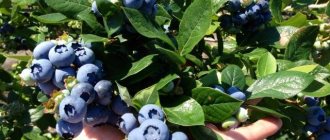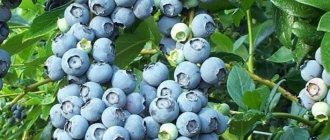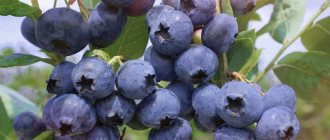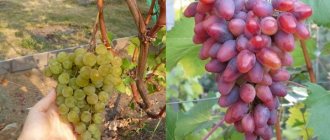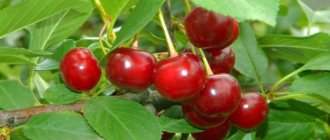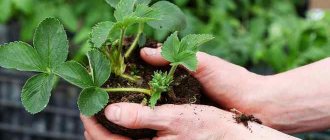Description of blueberry variety Blugold
Blugold blueberries belong to the group of tall varieties. This means that not compact bushes about 30-40 cm high will grow on the site, but a full-fledged plant with powerful upright shoots will form. The height of the bush can reach 1.2-1.5 meters. The root system is well developed. However, the roots lie at shallow depths.
The shoots are covered with elliptical single leaves. The small leaf blades have a glossy surface of bright green color. Gold Blue blueberries bloom with charming small bell-shaped flowers of white and pink color, which are collected in inflorescences of 8-10 pieces each.
Interesting fact! Many gardeners begin growing Bluegold Blueberries as an ornamental shrub. Its bushes attract the eye from early spring until late autumn. First with fresh greenery, abundantly covering the shoots, then with abundant flowering. In the summer, gardeners will be pleased with the earrings of blue berries, and in the fall its leaves will take on scarlet and purple hues.
Garden blueberries, including the Blugold variety, are still a rather rare guest of dacha estates in the post-Soviet space. Most likely for this reason, it did not pass the tests, was not included in the State Register and was not zoned. But the frost resistance and cold resistance of the variety allow us to assume that it will take root well not only in the central and southern regions of the country, but also in the northwestern regions and Siberia.
Most reviews from gardeners indicate that Blugold blueberries prefer to grow in sunny areas with good access to fresh air. It is demanding on soils and the depth of groundwater. It is not so much the chemical composition that is important as the mechanical properties of the soil. It should be light and breathable. It is desirable that it be podzolic in composition, with high acidity. When groundwater is close to the surface, blueberries of the Blugold variety are planted on hills or artificial ridges.
Photos of Blugold blueberries taken at the peak of fruiting show that the entire bush is densely covered with small clusters of berries. The berries are medium in size, and at the beginning of fruiting they are larger. On average, their diameter is 1.6-1.8 cm. Weight is about 3-4 grams. Breeders calculated that up to 70 berries can be placed in a 250-gram container.
Recommendations for planting
Blugold, like any other blueberry, is not least valued by gardeners for its unpretentiousness and ease of care. This is not surprising, because in nature it is found mainly in northern countries - Canada, Sweden, Norway, Iceland, where the climate is not mild.
Landing procedure and preparation for it
Choosing the right site for growing Bluegold blueberries is the key to a bountiful harvest in the future. She needs a place well warmed by the sun. A lack of light and heat negatively affects the taste of the berries; they become noticeably sour and the skin becomes coarser. It is advisable that groundwater does not approach the surface closer than 50–60 cm, otherwise it will be necessary to build an embankment 15–20 cm high.
The area should be protected from cold drafts, but, nevertheless, it is important to provide the possibility of ventilation. Otherwise, the bushes will suffer from pathogenic fungi.
It is advisable that at some distance from the blueberry bushes there is a natural or artificial barrier that protects from the wind
Blueberries prefer acidic soil (pH 3.5–4.5). The Blugold variety is less demanding on soil acidity; the optimal pH for it is 5.0–5.5. Therefore, the acid-base balance of the soil must be determined in advance. If it does not meet the required parameters, fresh manure, pine sawdust, pine needles, peat chips, colloidal sulfur are added to the soil, or the area designated for blueberries is spilled with acetic or citric acid. In this case, the substrate should be light enough and allow air to pass through well. Blueberries will not grow in heavy soils.
Acetic acid is one of the most common soil acidification agents.
The root system of Blugold blueberries is superficial, so the average depth of the planting hole is 35–40 cm, the diameter is about 0.5 m. When planting several plants at the same time, maintain a distance between them approximately equal to the height of an adult bush.
Blueberries have a superficial root system, so they do not need a deep planting hole.
At the bottom, a layer of drainage about 5 cm thick is required (brick chips, expanded clay, pebbles, clay shards). Then a mixture of high-moor peat, pine sawdust, and coarse river sand is poured into the pit. All ingredients are taken in approximately equal proportions. Fertilizers include Nitroammofoska, Diammofoska, Azofoska (25–40 g).
Nitroammofoska is a complex fertilizer, a source of all elements necessary for blueberries.
The so-called mycorrhiza must be added to the planting pit for blueberries. This is a community of plants and special fungi specific to all plants from the Ericaceae family. Mycorrhiza is vital for the proper development of the plant. If the seedling was purchased from a special nursery, it is already present in the top layer of soil. It must be preserved, just like the water in which the plant was soaked (it is used to water a newly planted bush).
Mycorrhiza is a kind of “fringe” at the tips of the roots of plants belonging to the Heather family.
Also, mycorrhiza in the form of a dry concentrate can be purchased in specialized stores, but there it is relatively rare. Another way is to find a place in the forest where blueberries, lingonberries, and cranberries grow, cut off some turf along with the roots, chop it and add it to the planting hole.
The soil under blueberries is a natural source of mycorrhiza
Video: preparing the soil for planting blueberries
Landing dates
The best time to plant blueberries is spring. You need to be in time before the leaves begin to bloom. Autumn is not very suitable because the weather in most of Russia is unpredictable. You need to be sure that there are at least two months left before the first frost. Only in this case will the bush have time to adapt to new living conditions and will not die in winter.
Selection of seedlings
The best option is a 1-year-old or 2-year-old seedling. They best tolerate the stress associated with transplantation. Bushes are purchased from specialized stores or trustworthy nurseries.
It is desirable that they be located in the same area as the site, or to the north.
High-quality planting material can only be purchased from reliable suppliers
Planting blueberries
The landing procedure has the following features:
- Blueberry seedlings are usually sold in small containers. 0.5 hours before planting, they need to be soaked together with the container in water, a pale pink solution of potassium permanganate or a solution of any biostimulant (potassium humate, succinic acid, Epin), prepared according to the instructions.
- The root system of blueberries is fibrous, the roots quickly become tangled. Before planting, the lower 2–3 mm of the “pile” is cut off with a sharp, clean knife. They also make 5-6 longitudinal cuts 1.5-2 cm deep, their edges are “fluffed”.
- The roots need to be placed closer to the surface, at a maximum depth of 6–8 cm. They are covered with the same mixture that was at the bottom of the planting hole. The soil is not compacted to ensure free access of air.
- Blueberries do not have a root collar, so there is no need to monitor its position. Gardeners' advice is to deepen the bases of the shoots into the soil by 3–5 cm. Then the bush begins to branch much more intensely.
- The seedling is watered abundantly, using at least 10 liters of water. Then the tree trunk circle is mulched, creating a layer at least 5 cm thick. This will significantly save time on weeding. The best material is chips or small pieces of coniferous tree bark, sphagnum moss. You can use any covering material, white or black. But peat is absolutely not suitable - weeds quickly grow through it, it does not absorb water well, diverting it from the bush.
After planting, the blueberry bush is watered and mulched.
Video: how to plant a blueberry bush correctly
Characteristics of the variety
Among the positive qualities of Blugold blueberry, which are present in the description of the variety, is its frost resistance. Plants in the middle zone can overwinter without shelter under a layer of snow. The root system and shoots can withstand frosts down to –30˚ –34˚C. The Blugold variety is not afraid of slight freezing of shoots. As a rule, the abundant formation of new buds allows the berry crop to quickly recover.
Another nice thing is that Bluegold blueberry flowers can withstand short-term drops in air temperature down to -7˚C. Residents of the middle zone, with its unpredictable weather conditions, will not be left without a harvest even with recurrent frosts.
Descriptions and reviews of Blugold blueberries indicate that it has a lot of other positive qualities. First of all, this is a cold-resistant variety. Its flowers are not prone to forming barren flowers and do not drop their fruits during prolonged cold spells. But hot and dry weather can damage the crop. At elevated air temperatures and lack of moisture, the berries seem to bake in the sun and mummify.
The Blugold variety is self-pollinating and does not need to be planted next to other blueberry species for cross-pollination.
Features of fruiting
Blugold blueberries are a variety with medium-late berry ripening. It begins to bear fruit 3-4 years after planting. Collection begins in the second half of July. Fruiting is friendly. The harvest can be harvested in one go. It is important not to miss the moment, as overripe Gold Blue blueberries quickly crumble. Their ripeness is indicated by the easy separation of the berries from the stalk.
Depending on the conditions, the yield of Blugold blueberries ranges from 4.5 to 7 kg. The number of berries collected is directly affected by:
- soil composition with an optimal ratio of nutrients and acidity;
- pruning excess shoots;
- age of the plant: the older it is, the higher the yield.
Blugold blueberries, thanks to their thick skin, have high shelf life and good transportability.
Attention! To extend the shelf life of Bluegold blueberries, they are collected by hand in small containers lined with napkins and placed on the bottom shelf of the refrigerator. In this state they can be stored for up to 2-3 weeks. Excess can be frozen. When defrosted, Bluegold blueberries do not lose their shape or taste.
The use of Bluegold blueberries in cooking is quite wide. Compotes, jams, and preserves are made from it. Dense berries will be an ideal decoration for confectionery products.
Harvesting and storage
If the berry easily comes off the stalk, then it is ready for harvesting. There is no point in postponing the moment of picking berries - they may fall off.
Start cleaning after the dew has dried, moving from top to bottom. Place the berries in small containers lined with a paper or cloth napkin.
In this form, the harvest is stored for 12-15 days on the refrigerator shelf; frozen berries are stored for up to 6 months.
Vitamins are well preserved when preparing berry puree with added sugar, but it should not be stored in the refrigerator for too long.
Features of reproduction
Blugold blueberries are propagated by cuttings. It is worth considering that two-year-old seedlings are planted in a permanent place. You can try to propagate the bush by layering. In the spring, one of the shoots is dug in and cared for like the rest of the bush. By autumn there will be a good seedling. But it is recommended to plant blueberries in the middle zone in the spring. The question again arises of where to store it until planting.
Most gardeners prefer to buy ready-made two-year-old blueberry seedlings from nurseries. It must be grafted, have two or three shoots with buds and a healthy root system.
Advantages and disadvantages of the variety
The Blugold variety has many advantages over other similar berries:
- long-term storage possible;
- dense berry pulp;
- large volume of harvest;
- self-pollinating variety;
- resistance to low temperatures.
However, this variety also has several disadvantages, although not too significant:
- in the heat, the berries dry out quickly;
- when overripe, the fruits fall off;
- The bush grows very quickly.
Planting blueberries Blugold
Blugold blueberries are planted in the spring. In the southern regions, autumn planting is also possible. It is worth considering that at least two months must pass from the moment the seedlings are planted in the ground until the onset of cold weather.
- Before planting Bluegold blueberries, prepare holes about 50 cm deep and wide. If a drainage layer is not required, the hole is dug to a depth of about 40 cm.
- Drainage is arranged from broken bricks, slate or coarse crushed stone.
- A mixture of soil, peat, sand and pine needles is poured on top in the form of a mound. Add 40-50 grams of nitrogen-containing fertilizers.
- The cuttings are planted on a mound, trying not to bury it.
- Carefully fill with the same mixture. Water and mulch the root circle with sawdust or pine needles.
Bonus
If you see blueberries the size of a coin at the market, there is a 99.9% chance that these are Bonus berries. Perhaps this is the largest-fruited tall blueberry that you can grow in your summer cottage.
The berries themselves are aromatic, dense, and sweet. They are suitable for both fresh consumption and freezing. This blueberry produces a good harvest and withstands frosty winters. Isn't it a gardener's dream?
| Maturation | Bush height (m) | Berry diameter (mm) | Productivity (kg per bush) | Peculiarities |
| July August | 1,5-1,6 | 20-30 | 5-8 | Good winter hardiness |
Caring for Blugold blueberries
In the first year, the Blugold variety only needs watering and mulching of the root circle. From the second, fertilizing begins. The first is done in early spring using nitrogen-containing fertilizers. During the summer, complex formulations containing potassium, sulfur, magnesium and phosphorus are used.
Pruning of Gold Blue blueberries begins from the 6th year of the plant’s life. It's not complicated. In early spring, before sap flow begins, dried and non-fruit-bearing, as well as thin basal stems are cut out, with the exception of the 2-3 strongest shoots.
TOP 10 most popular varieties
The best varieties of garden blueberries rightfully include:
- Reka is a tall bush with dense, juicy, medium-sized berries, collected in a tight bunch. One of the early fruiting varieties. Suitable for beginner gardeners, as it is unpretentious, frost-resistant and practically does not get sick. The berries have a sweet dessert taste and a pleasant aftertaste. The harvest remains on the branches for a long time without falling off.
- Patriot - this variety begins to bear fruit at the age of 5. The bushes are low, with dense, medium-sized berries, collected in a tight bunch. The yield is high, but there is a danger of fruit crushing in subsequent years.
- Duke - has a tall bush with a lush crown. The berries ripen very early and evenly. Despite early ripening, they bloom late and are not afraid of spring frosts. The harvest is always high, more than 6 kg. The berries in the bunch vary in size, but have a pleasant fruity taste . The harvest is well stored and transported.
Should be considered! During the period of harvest ripening, it is recommended to tie up branches overloaded with fruits.
- Northland is quite consistent with its name (English: Northland). The variety is incredibly resistant to frost (up to -40°). The bush is short, squat, but with a lush crown. Together with other plants it can be used as a hedge. Easy to care for. The berries are very sweet and aromatic.
- Coville - has a very tall bush with a spreading dense crown, making pruning difficult. The brushes are loose. The berries are quite large (up to 16 mm in diameter), with a bluish coating. The taste is sweet with sourness. The variety ripens at the end of August. It is preferable to eat fresh.
- Spartan - acquires strength and fruiting power after 6-7 years. By this time they reach 2 meters in height and have a spreading, woody trunk. Young foliage is red, turning green as the fruit ripens. The flowers are small, bell-shaped and pale pink. The variety produces consistently high yields . The berry is quite large ( 18 mm ) and heavy, with a pleasant sweet taste and aroma. The thick skin ensures good preservation of the fruit.
- Northblue is a low-growing bush with a fluffy crown. The berries are quite large with thin skin. Sweet and fragrant. Productivity is high and stable. Not afraid of cold weather and spring frosts. Very unpretentious.
- Elizabeth. This medium-high frost-resistant variety is a leader in taste. The ripening of the berries lasts several weeks. The berries are very large. Sweet and aromatic, with high yield. Stores well and does not shrink.
Interesting! The undeniable advantage of Elizabeth blueberries is that with good care they bear fruit for up to 60 years!
- Chippewa is a low-growing variety with an abundance of large berries with a sweet dessert aroma. Productivity is up to 3 kg per bush. However, the berries do not ripen at the same time, which makes processing difficult. The variety is suitable for central Russia.
- North Country is a variety with high frost resistance. Preferred for northern regions. The bush is small, with a compact crown. The berries are light blue with a coating. Juicy and moderately sweet, with a regular taste. The variety is valuable for its endurance and unpretentiousness.
Diseases and pests
The Blugold variety is resistant to most diseases. In the spring it is recommended to treat it with antifungal drugs. It is worth remembering that even if the plant is diseased, it is not necessary to carry out treatment less than three weeks before harvesting.
Of the pests, the greatest damage to Blugold blueberry bushes can be caused by the larvae of cockchafers, which like to settle in the roots of perennial plants. They are easy to notice when loosening the soil and can be removed.
You can learn about the main characteristics of the Blugold blueberry variety from the video review
Seasonal care
Watering, fertilizing, pruning the bush, mulching and loosening are a necessary set of measures for caring for blueberries.
Watering
The recommended soil moisture for Bluegold blueberries is about 70% (soil clenched in a fist retains the shape of a lump, which disintegrates when thrown to the ground). The watering regime should be such that the top 15–20 cm of the substrate never dry out completely. But you can’t turn them into a swamp either. Water that stagnates under a bush for two days or more inevitably leads to its death.
The soil at the roots of the blueberry bush should be slightly moist, but not wet.
If the summer is rainy, you can skip watering altogether; in hot weather it is required every 2-3 days (you will also have to spray the leaves). The norm for an adult plant is 10–15 liters. It is advisable to water in the late afternoon. The best way is sprinkling, simulating natural precipitation. Do not pour water under the roots - they are located very close to the surface, it is easy to wash off the soil from them, which will lead to drying.
Once every 1.5 weeks, ordinary water is replaced with acidified water (1–2 ml of acetic acid or approximately 5 g of colloidal sulfur per 10 liters of water).
Recent Entries
Lilac perennials that are beautiful, compact and do not crowd out other plants Why when buying seedlings you should not take the sellers’ word for it and how to determine the age of the plant using 3 signs Tomato seedlings have turned purple or whitish: why the color has changed and how to save the plants
In hot weather, blueberry leaves are regularly sprayed with a spray bottle or doused with water from a watering can.
After watering, the soil under the bushes is loosened 3–4 times a season, but only very carefully, to a depth of no more than 5 cm. The mulch is not removed; at the end of the procedure, it is advisable to renew its layer.
Feeding
Of the macroelements, blueberries need nitrogen, phosphorus and potassium. For an adult bush, it is enough to apply about 100 g of nitrogen-containing fertilizers (urea, ammonium sulfate, ammonium nitrate), 110 g of phosphorus (superphosphate) and 40–50 g of potassium (potassium sulfate).
Urea, like other nitrogen-containing fertilizers, stimulates blueberry bushes to increase green mass
Urea is applied in two doses, at the beginning and end of May, in equal portions. In mid-June and after harvesting, the bushes are fed with phosphorus and potassium. In the second half of summer, the application of nitrogen-containing fertilizers is not recommended.
Bushes aged 5 years and older need more nitrogen - 250–300 g of fertilizer. They are applied in three doses: half in early spring, when the leaves bloom, another third in early May, and the remainder in the first ten days of June.
No organic matter (manure, compost, humus) is used to feed blueberries, as well as a natural alternative to mineral fertilizers (wood ash, leaf infusion). Any fertilizers containing chlorine, for example, potassium chloride, are also strictly contraindicated for her.
Bluegold blueberries are sensitive to magnesium deficiency. During the season, potassium magnesium or magnesium sulfate is added in dry form or in the form of a solution (about 15–20 g in total). Deficiencies of other microelements are compensated by diluting 2–3 g of boric acid, zinc sulfate, and copper sulfate in 10 liters of water. The bush is watered with this solution in the first ten days of June and at the end of September. An alternative is complex liquid fertilizer (Agricola, Kemira-Lux, Ideal).
Potassium magnesium is a fertilizer containing magnesium, the deficiency of which blueberries are very sensitive to.
Video: important nuances of caring for blueberries
Trimming procedure
Pruning for Blugold blueberries is a mandatory procedure that allows you to almost double the productive period of the bush. The first time it is carried out when 6 years have passed after planting the seedling in the ground. Before the growth point, all 5-6 year old shoots that no longer bear fruit are removed. They also get rid of all short “empty” branches, especially those located at the very roots. Of the shoots under 3 years of age, 4–6 of the strongest and most developed ones are left, the rest are also cut off. The next year, the remaining branches are pinched to the 5th flower bud. In this case, very large berries ripen on them.
Wood ash helps disinfect wounds caused to the plant during pruning.
For pruning, use only disinfected and sharpened scissors and pruning shears. The wounds are immediately sprinkled with crushed chalk, colloidal sulfur, sifted wood ash, and powdered activated carbon. This is a “gateway” for all kinds of pathogenic fungi, to which blueberries are quite susceptible.
To trim blueberries, use only a well-sharpened tool, sterilized in a dark purple solution of potassium permanganate for at least 0.5 hours.
If there are several blueberry bushes growing on the site, you need to make sure that their branches do not intertwine with each other. This delays the ripening time of the berries and negatively affects their taste.
Pruning is carried out once a year, in early spring (before the leaf buds “wake up”) or in the fall (after the end of leaf fall). At the same time, practice shows that if it is carried out less frequently, the harvests become more abundant, but at the same time the berries become smaller and ripen much later than usual.
When pruning blueberries, get rid of the oldest shoots first.
Preparing for winter
Bluegold blueberries have good frost resistance. Only non-lignified young shoots can be damaged by the cold, but they also quickly recover during the season. Therefore, you can refuse a special shelter, unless an abnormally cold and little snow winter is predicted. A snowdrift with a height of about 0.5 m, renewed several times per season, is sufficient.
The plant is especially loved by hares and other rodents. To prevent their attacks, branches of any coniferous trees are tied to the base of the shoots. You can surround the bush with a ring of strong mesh.
In winter, Bluegold blueberry bushes, as a rule, do not need any shelter other than snow.
Diseases and pests typical for blueberries
Most often, Bluegold blueberries suffer from all kinds of pathogenic fungi. Infestation is especially difficult to prevent if the summer is cool and rainy. This weather promotes the development of various types of rot.
Gray rot is one of the most common fungal diseases that affects blueberries.
For prevention in the spring, the bushes are treated three times with a 2% solution of copper sulfate or Bordeaux mixture, or any modern fungicides are used (Topsin, Skor, Horus, Abiga-Pik). The first time is sprayed on unblown leaf buds, the second time - 3-4 days after flowering. The last treatment is 1.5–2 weeks after the second. A month after harvesting, the bushes are sprayed twice with an interval of 2-3 weeks with a solution of Strobi and Rovral.
Bordeaux mixture is one of the most popular and effective fungicides, which is easy to prepare yourself.
If suspicious symptoms are detected, blueberry bushes are treated with Topaz and Fundazol. If necessary, the procedure is repeated after 7–10 days.
The plant is not immune to bacterial and viral diseases (mosaic, cancer, dwarfism, necrotic spotting). It is impossible to cure blueberries even at the earliest stages of their development using modern means. The best thing to do is to immediately uproot and burn the bush so as not to infect nearby plants.
Bacterial cancer is a dangerous disease for which there is currently no cure.
Blueberries, as a rule, are rarely subjected to massive attacks by harmful insects. The exceptions are larvae and adults of the cockchafer, leaf roller and silkworm caterpillars, and aphids. Having discovered them, the bushes are sprayed 2-3 times with an interval of 7-12 days with Actellik, Inta-Vir, Karbofos. May beetle larvae can also be collected by hand; they are quite large and clearly visible on the bush.
It must be remembered that the use of any insecticides is undesirable during flowering and is prohibited at least 20 days before the expected harvest date.
Adults and larvae of the cockchafer cause serious damage to blueberry bushes, eating away flower buds from the inside.
Birds can cause significant damage to blueberries. To protect the crop, a fine mesh net is carefully pulled over the bush. You can also build repellers from foil, colored ribbons, and bright paper, but practice shows that birds literally get used to them within a few days.
The net is the only thing that can reliably protect blueberry bushes from birds
Reviews of blueberries Bluegold
Sergey, 48 years old, Saransk My wife bought Bluegold blueberries - she had read a lot of descriptions and positive reviews on the Internet. And in the photo the bushes look very attractive. They planted two bushes, but for some reason one died. The second one grew and even bore fruit last year. We picked a small cup of berries for the delight of our grandchildren. Now I want to multiply it again so that there are at least 4-5 bushes, otherwise there won’t be any left for harvesting.
Svetlana, 33 years old, Saratov I bought the blueberry variety Blugold a couple of years ago. Haven't tried the berries yet. It just bloomed this year. Very plentiful. The plant became a real decoration of the site. The bushes fit perfectly into the design. In winter I cover it with spruce branches and agrofibre on top. Winters well.
Larisa, 50 years old, Balashikha I have been growing blueberries of the Blugold variety for about 10 years. And every year it becomes more and more beautiful, and the harvest is more and more. In the spring, I thoroughly loosen the root circle and fertilize it with compost, and generously cover it with a mixture of pine needles and sawdust. I don't like peat. Weeds grow through it too quickly. For the winter, I compress the bushes and tie them with burlap. In the summer I only water it, sometimes adding table vinegar to the water. That's all the secrets of a good harvest.
The best varieties for different regions
For the Moscow region and central Russia
The climatic conditions of central Russia are perfect for growing berries. Quite long summers and moderately cold winters have a beneficial effect on yields, especially with proper feeding of blueberries.
Something to remember! Blueberries prefer high acidity of the soil. Soddy-podzolic and sulfur forest soils of the Moscow region must be deoxidized with lime.
All varieties with frost resistance from -30° are suitable for the middle zone and Moscow region.
Geographical distribution
Blueberries are a perennial plant found throughout the Northern Hemisphere. It is well adapted for growth in temperate and cold climates, which is why it grows from the Far East and Japan to the Scandinavian countries. In North America it is distributed from Alaska to California. Natural habitat is along river floodplains, sometimes in swampy areas.
Blueberries are represented by several types of bushes:
- short - up to 10 cm in height;
- tall, the vines of which reach 4 m.
Low-growing varieties of this crop are grown on an industrial scale. Its varieties differ in climatic suitability, growth characteristics and ripening season. You can plant several varieties with different harvest dates nearby to extend the season for fresh berries.
Jersey
This is an old variety of tall blueberry, proven by thousands of gardeners. If you expect low maintenance and a stable harvest from a berry bush even in less favorable years, you will certainly like Jersey.
Blueberries of this variety take root well on different types of soil, tolerate frost well, and are resistant to diseases and viruses, in particular to the red ring spot virus.
Jersey berries are small, light blue in color and round in shape. Thanks to their delicate sweet taste, they are perfect for processing: making homemade baked goods, jams, compotes. In addition, the blueberry harvest of this variety is well stored and is suitable for freezing.
| Maturation | Bush height (m) | Berry diameter (mm) | Productivity (kg per bush) | Peculiarities |
| Mid August | 1,6-2 | 15-16 | 4-6 | Resistant to red ring spot virus |
Herbert
The Herbert blueberry variety is one of the best you can grow in your garden. This is a tall blueberry in the full sense of the word - the height of the bush can reach 2.2 m!
Of course, the fruits are not as gigantic as those of Bonus, but still quite large - about 2 cm in diameter. They have a delicate taste, they do not crumble or crack when overripe.
Bushes of this variety reproduce easily, winter well, produce up to 9 kg of harvest per season and are unlikely to cause you much trouble.
| Maturation | Bush height (m) | Berry diameter (mm) | Productivity (kg per bush) | Peculiarities |
| Mid August | 1,8-2,2 | 20-22 | 5-9 | Easy to propagate |
